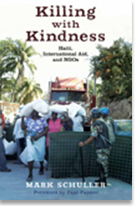 "The NGOs" by Mark Schuller, Ph.D.
"The NGOs" by Mark Schuller, Ph.D.
Schuller is Assistant Professor of Anthropology and NGO Leadership Development at Northern Illinois University and Affiliate in the Faculté d’Ethnologie at the Université d’état d’Haïti. He co-directed "Poto Mitan" and is the author of Tectonic Shifts (2012) and Killing with Kindness (2012).
Haiti is one of the most thoroughly NGO-ized societies in the world; it has often been said that Haiti has the "most NGOs per capita." Given their high visibility and centrality, NGOs have become the topic of conversation, analysis, and critique. Especially following the earthquake, Haiti has become known as the "Republic of NGOs." This is true not only because nongovernmental organizations (NGOs) are increasingly playing central roles in Haiti, as elsewhere. In 2009, UN Special Envoy Bill Clinton estimated 10,000 NGOs working in the country, calling to question the meaning of the term. Mostly identified by what they are not, there have been several attempts to understand and unpack the ever-increasing array of private structures. In Haiti, the first book-length study of NGOs was done by NGO researchers involved with GRAMIR (Groupe Reflection et Action dans le Milieu Rural), in 1989. The authors devised a four-part classificatory schema, slightly adapted by Faculté d’Ethnologie MA student Sauveur Pierre Etienne, who captured the sentiments of many with his provocative title (the "invasion" of NGOs). Other Haitian scholars such as the late Janil Lwijis (Jean-Anile Louis-Juste, assassinated on January 12, 2010) pushed the critique further.
NGOs became officially recognized in a December 1982 decree, modified by Namphy in September 1989. Significantly, NGOs must be apolitical, non-profit, and work toward development using specific means. The Ministry of Planning (MPCE) through a specific office called UCAONG is responsible for official recognition and oversight of NGO activities. The number of officially registered NGOs was about 400 at the time of the earthquake. There was a sudden rise in NGOs in the period immediately following Duvalier’s ouster during the dechoukaj period, and another spike after the restoration of the democratic order in 1994.
Begun as a private, voluntary structure tied to transnational religious groups and characterized by a shared sense of mission, since the mid-1990s, NGOs began eclipsing the government in terms of official development aid, especially at USAID but other bilateral donors. With this aid NGOs have become professionalized and increasingly multi-sectorial. One NGO director candidly reported, "Essentially, we follow the money." As official sources eclipsed voluntary donations, NGOs risked being instrumentalized, using aid for other purposes, particularly to implement donors’ official foreign policies. NGOs are also seen as one of the most lucrative job opportunities, typically paying three times the salary of agencies within the Haitian government. Some people began speaking of an insular "NGO class." The trend of foreign support to NGOs continued. In the first decade of the 21st century, 90 percent of schools and 80 percent of clinics were run by NGOs. In some, particularly rural areas, NGOs have largely displaced the state.
Evaluating NGOs remains a difficult task because of their sheer number and diversity, and the multiple mandates that they are called upon to fulfill. NGOs also have different meanings to different people. However, particularly after the earthquake with billions in promised aid and little concrete progress, NGOs became unpopular in Haiti, the subject of graffiti and popular music lyrics. Coordination was cited by the UN as a major challenge within the NGO system, as was the need to work within the authority of the Haitian government. These two themes have been consistently proposed since the first studies of NGOs were commissioned in the 1980s, but became more visible following the earthquake. NGOs’ future in Haiti thus remains uncertain.